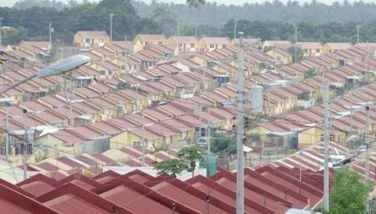Preparing for the next one

I know. We are not quite done with the last big one. But strangely enough, now is an appropriate time to start thinking of how to prepare for the next one while the lessons of the last one are still fresh in our minds. Once things really get back to normal, the sense of urgency will be lost and all those thousands of our countrymen died in vain.
We have clearly seen that government’s disaster response planning fall short in many ways. Let me cite one example and I am sure there are many others.
I was told that the PNP SAF was ready to deploy on day 2 or Saturday. They were indeed at Villamor but were unable to get a ride on the C-130s for some reason. They waited the whole day, but nothing happened. Some managed to leave the following day when commercial airlines agreed to bring them to Cebu.
If they got to Tacloban on Day 2 or even Cebu for immediate airlift to Tacloban, the security problems would have been avoided. It was unfortunate that the disaster response planning did not include transporting the augmentation team of the PNP... ridiculous, isn’t it?
As pointed out by former CNN correspondent Maria Ressa, a seasoned reporter with experience covering more disasters than she cares to remember, security is the first concern in a post Yolanda situation. Other concerns cannot be addressed if security is absent.
It was also not very reassuring that Defense Secretary Volt Gazmin was quoted saying they didn’t send military troops in the early days because they were afraid the troops will have nothing to eat or drink given the devastation. But wasn’t the Army placed on alert before Yolanda made landfall? Isn’t providing meals for deployed troops part of military planning?
Why is quick response essential? Again, Maria Ressa points out why:
“Every disaster responder and aid group will tell you the first 24 hours are crucial. There’s a small window for rescue operations. If you miss that, more people will die…
“In times like this, every minute counts. Every minute means a life. That’s true for those trapped in the rubble and for those who survive. Why? Because every minute they don’t have food and water has both a physical and psychological toll. If you leave them alone, desperation sets in. And anarchy follows.â€
This is why it is necessary to assess the government’s response to Yolanda so that we will do better next time, as Sec. Sonny Coloma promised.
To me, the first order of business is for P-Noy to appoint a Disaster Czar. The joint chairmanship of NDRMMC by the Secretary of Defense and the Secretary of Interior doesn’t work. Both are busy with their regular assignments in normal times and when calamity strikes, we need just one man on top of everything. Mar Roxas claims they manage by consensus and that explains the chaos. Managing a crisis requires a ground commander.
No, that one man cannot be the President because like the SILG and SND, he has a lot of things on his plate. The President has command responsibility, of course. But there should be one man of Cabinet rank who lives and breathes disaster response day in and day out even in normal times. And when disaster strikes, he must have the power to commandeer all assets of government and even the private sector as necessary to deal with the crisis.
Having one man accountable for disaster response will minimize if not eliminate finger pointing on who is responsible. When something like Yolanda strikes, everyone in government other than the President reports to this one man. You can be a Mar Roxas or a Volt Gazmin, but you are under this one man calling the shots for disaster response.
This Disaster Czar will work only if P-Noy gets over his reluctance to appoint beyond his small circle of friends and party mates otherwise known as the Student Council. This Disaster Czar must be totally competent and able to command respect from bureaucrats and citizens alike. International stature will help.
Offhand, the people that come to mind as capable of performing this role are Gov. Joey Salceda, Roy Golez and Raffy Alunan. Gov. Joey has proven himself in this area as he disaster-proofed Albay, a province prone to typhoons and volcanic eruptions. Gov. Joey’s ability in this area is now internationally recognized. As a governor, he knows how to get the cooperation of LGU heads.
Roy Golez just finished serving three terms as congressman from Paranaque. He has proven himself through the years specially when he was assigned to clear up the mess at the Post Office. He has strong credentials in logistics management and his background in the military (an Annapolis graduate) should serve him well.
Raffy Alunan was DILG Secretary during the Ramos watch. Raffy’s private sector career also exposed him to challenges similar to what a Disaster Czar will face. An active reservist, Raffy has his military connections that should come in handy too.
Any one of those three should do a creditable job or at least vastly improve on what we have just seen. AIM Prof Mayo Lopez has other suggestions on how to make things better which he shared in one of my e-groups.
That revitalized NDRMMC is one suggestion. Mayo thinks it must “build a level of what Nassim Taleb calls ‘anti-fragility’ into our national systems that could withstand most ‘black swan’ natural and certain man-made events which we now classify as disasters and calamities.â€
This super disaster agency will purchase, produce, or otherwise procure those badly needed naval (transport and landing craft), air (STOL fixed wing cargo planes and larger cargo helicopters) and land transport, and search and rescue assets that will be needed to respond faster and more adequately. Can you believe they don’t even have one satellite phone?
“We need to construct and maintain all-weather landing strips in many parts of the country that can also support commercial aviation in normal times. We have the technicians to fix commercial and general aviation craft. We should be able to start a small aircraft assembly industry just as Indonesia did in the 1980s.â€
That super disaster agency must “build and be responsible for the upkeep and updating of emergency supply depots in safer and strategic parts of the country most likely to be hit by natural disasters, complete with large helicopter landing pads, to store emergency food items and potable water (to be put in place at least a few days before a foreseeable disaster strikes), medicines and medical equipment, sets of appropriate tools such as chain saws, generators, emergency lights, large tents, etc., such as those we have seen in movies and media coverage of similar events elsewhere. Such depots may include emergency medical (first aid, emergency room) operations and temporary evacuation centers.â€
It will be “in charge of forming, training, and constantly retraining disaster response teams, and placing them on immediately alert, then full-field deployment of the teams and their necessary equipment days before a possible known natural calamity -- storms and typhoons lend themselves to these kinds of anticipatory responses.†In this regard, it will work with other agencies of government.
Prof Lopez also envisions this agency to “give to our scientists and IT specialists the task of creating computer models needed to help simulate how nature might act at its worst -- typhoons and their likely paths, earthquakes, floods -- in any area in the country, hence helping us anticipate eventualities and what we might do to keep people out of harm’s way, and ensure that these models are cascaded to the public through multi-media.â€
“It will coordinate building needed communications infrastructures that can withstand the more severe disasters and remain functioning during and after the disasters…â€
This agency should be on top of disaster relief logistics, and must “organize relief transport programs, engaging commercial land, sea, and air transport companies to become part of emergency transport brigades, utilizing appropriate assets for these operations.â€
Space limitation prevents us from including a few more suggestions of Prof Lopez that ought to be considered as we plan for the next big one.
Doing better the next time requires P-Noy to honestly assess the performance of every member of his team. “If any of the team is found wanting, a resignation is called for and a replacement immediately made with people of known competence and integrity.â€
Mayo continues: “If Benigno S. Aquino III has failed in this moment, I think the failure is because there are those in his immediate circle of followers who did not serve the national cause well…â€
I believe there are enough Filipinos who are more competent than P-Noy’s kabarkada in managing disaster response.
There will definitely be a next one and it could be bigger than Yolanda. We must be prepared for that one and no more excuses.
Boo Chanco’s e-mail address is [email protected]. Follow him on Twitter @boochanco
- Latest
- Trending




























